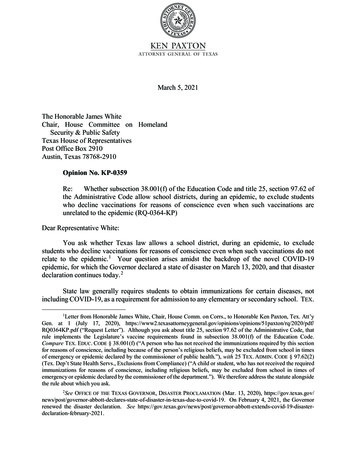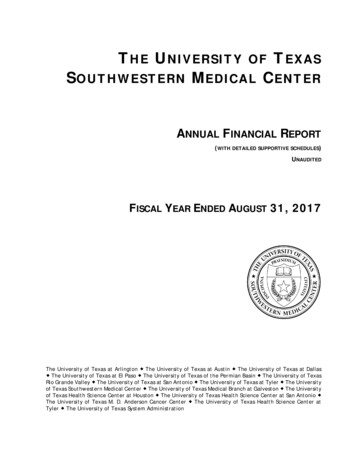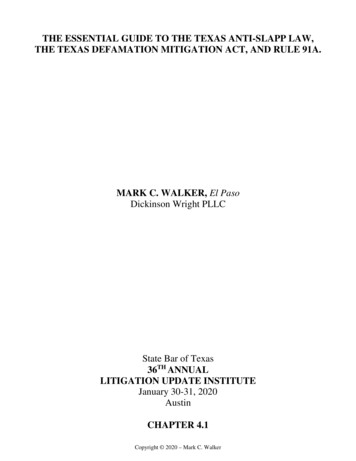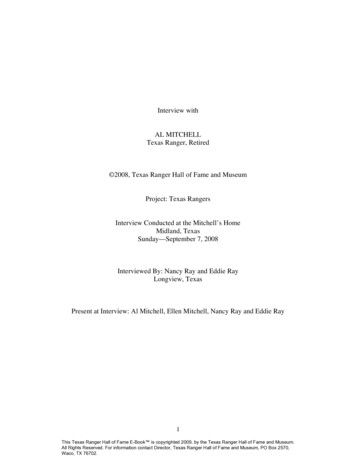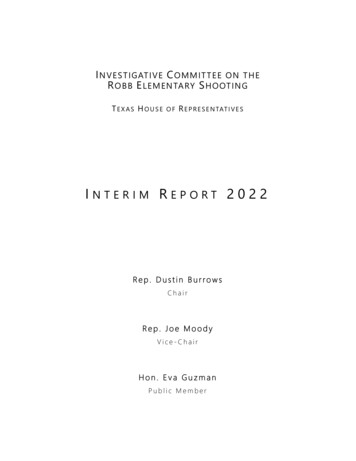
Transcription
I N V E S T I G AT I V E C O M M I T T E E O N T H ER O B B E L E M E N TA RY S H O OT I N GTEXAS HOUSEOFR E P R E S E N TAT I V E SINTERIM REPORT 2022Rep. Dustin BurrowsChairRep. Joe MoodyVice-ChairHon. Eva GuzmanPublic Member
TA B L EO FCO N T E N T SPreface -----------------1Acknowledgments ---1Dedication -------------11 Introduction & Executive Summary -------------------------- 5The School ------------------ 5The Responders ------------ 72 Background & History of Investigation -------------------- 103 Robb Elementary School Security & Facilities Overview -------------------------------------------------- 13Uvalde CISD Police Department ---------------------------------------- 13Active Shooter Plan ------14ALERRT Standard for Active Shooter Training ---------------------- 17Rise of “Bailout” Security ---------------------------------------------- 22Raptor Alert System ------23Uvalde CISD Facilities & Maintenance --------------------------------- 24Robb Elementary Facilities & -------------------------------------- 24Policies for Locking --- 25Maintenance of Doors & ----------------------------------------------- 274 The Attacker ---- 29Family & Early Life -------29School ----------------------- 30The Year -----------------32The Last Days -------------345 May 24 Incident & Law Enforcement Response ---------- 39Coach Silva Alerts the School -------------------------------------------- 41Law Enforcement Responds to Robb ------------------------------ 41Robb Elementary School Locks Down --------------------------------- 44The Attacker Enters the West Building --------------------------------- 46The Attacker Enters Rooms 111 & 112 -------------------------------- 46First Law Enforcement Approaches & Enters ------------------------ 48What Happened for the Next 73 Minutes? ----------------------------- 52On the South ---------- 52On the North ---------- 58On the Outside -------- 62What Didn’t Happen in Those 73 Minutes? --------------------------- 62Law Enforcement Responder Headcount ------------------------------ 646 Information Flow ------------------------------------------------ 66The First Reports ---------66ALERRT Report ---------- 67Video Evidence -----------68Compromised Trust ------ 697 Factual Conclusions --------------------------------------------- 70
PR E F A C EThis is the interim report of the Investigative Committee on the Robb Elementary Shootingof the Texas House of Representatives.Conscious of the desire of the Uvalde community and the public at large to receive an accurateaccount of the tragedy at Robb Elementary School, the Committee has worked diligently andwith care to issue this interim report of its factual findings. The Committee’s work is notcomplete. We do not have access to all material witnesses. Medical examiners have not yetissued any reports about their findings, and multiple other investigations remain ongoing. TheCommittee believes this interim report constitutes the most complete telling to date of theevents of and leading to the May 24, 2022, tragedy.This Committee has prioritized factual accuracy, as will be evident from our attention toconducting our own interviews and documenting our sources of information. Still, based onthe experiences of past mass-shooting events, we understand some aspects of these interimfindings may be disputed or disproven in the future.The Committee issues this interim report now, believing the victims, their families, and theentire Uvalde community have already waited too long for answers and transparency.AC K N O W L E D G M E N T SThe Committee gratefully acknowledges the assistance of all who helped with its investigationand the preparation of this interim report, including Clement Abbondandolo, Margo Cardwell,Courtney Chaplin, Matthew Crow, Casey Garret, Harrison Garrett, Paige Higerd, Ted Liggett,Michael Massengale, Kolton McDougald, and Ellic Sahualla.DE D I C AT I O NThe Committee submits this report with great humility and the deepest respect for the victimsand their families. It is the Committee’s sincere hope that this brings some clarity for them asto the facts that happened. This report is meant to honor them.You will notice the name of the attacker is not mentioned. We also will not use his image, soas not to glorify him.Robb C mte Rpt 1 of 77
Nevaeh Alyssa BravoNeveah is remembered as a playful girl who put a smile on the faces of everyone around her.Her family meant the world to her, and she often helped her father around the house. Neveahloved the colors pink and purple and enjoyed playing softball and riding her bike.Jacklyn “Jackie” Jaylen CazaresJackie is remembered as a caring girl who enjoyed singing and making TikTok videos. Jackieloved animals (especially her four dogs) and wanted to become a veterinarian; she also dreamtof visiting Paris. Jackie was known as someone who would go out of her way to help anyone.Makenna Lee ElrodMakenna is remembered as the light in the lives of those who knew her. She loved the colorpurple, softball and gymnastics, and spending time with her family—especially time on theranch with her dad. Her smile lit up rooms, and she liked to leave hidden notes for her familyto find.Jose Manuel Flores, Jr.Jose is remembered as loving and kind. He was an honor roll student who wanted to be apolice officer when he grew up to help protect other people. Jose was an amazing big brotherwho looked out for his siblings, and his parents called him “a helper” because he was alwayspitching in at home.Eliahna “Ellie” Amyah GarciaEllie is remembered as a gentle, kindhearted girl who loved spending time with her family andwas very close with her grandparents. She enjoyed playing basketball and wanted to be acheerleader one day. Ellie adored the colors pink and purple and loved a nice bowl of ramennoodles. She was a long-term planner who was already picking dresses and dances for herquinceañera five years away.Irma GarciaIrma is remembered as courageous and selfless—a wife and mother of four who was alwayswilling to lend a helping hand to anyone who needed one. She was a 23-year teacher. Irma diedprotecting her students, and her heroism will be remembered forever.Uziyah Sergio GarciaUziyah is remembered as an outgoing boy who loved his family as well as his “cousins andbrothers from another mother.” He was always fair and full of life, and he enjoyed running,swimming, football, and playing his Nintendo Switch and Oculus.R o b b C m t e R p t 2 of 7 7
Amerie Jo GarzaAmerie is remembered as considerate and fun-loving. She was protective of her three-year-oldbrother and would kiss him every morning before she went to school. Amerie lovedswimming, drawing, and vanilla bean frappés from Starbucks. She dreamt of becoming an artteacher one day.Xavier James LopezXavier is remembered as an active boy who loved swimming and playing little league baseballfor his team, the Blue Jays. He was lively, energetic, and always eager to dance, especially thecumbia with his grandmother. Xavier was known for wearing stylish clothes and had a smilethat could cheer anyone up.Jayce Carmelo LuevanosJayce is remembered as a happy, thoughtful boy with many friends who always seemed to berunning around his yard with him. He made his grandparents a pot of coffee every morningand would leave notes saying that he loved them. Dinosaurs were one of his favorite things.Te s s M a r i e M a t aTess is remembered as a natural athlete who enjoyed softball, soccer, and gymnastics—sheespecially loved doing backbends in gymnastics. Tess was a fan of the Houston Astros andeven played the same position as her favorite player, José Altuve, in softball. She was savingup money for a family vacation to Disney World.Maranda Gail MathisMaranda is remembered as smart and nice, a shy tomboy who loved the color purple, especiallywhen it was on unicorns and mermaids. Maranda also enjoyed spending time outdoors andhad an incredible imagination.Eva MirelesEva is remembered as dedicated and vibrant. She enjoyed CrossFit, hiking, spending time withher dog, Kane, and being with her family. Her smile was bright and her commitment to herstudents was still unwavering after 17 years as an educator. She was a hero who never gave upthroughout an impossible ordeal.Alithia Haven RamirezAlithia is remembered as talented and bighearted. She was a gifted artist who wanted to go toart school in Paris one day. She was also a mature role model to her siblings and was alwaysthoughtful about helping those in need.R o b b C m t e R p t 3 of 7 7
Annabell Guadalupe RodriguezAnnabell is remembered as empathetic and loyal. She enjoyed spending time with her sistersand watching TikToks. Her favorite color was blue—especially blue found on butterflies.Annabell was on the honor roll and known for being a sharp student.Maite Yuleana RodriguezMaite is remembered as sweet and competitive. She loved learning about animals and theocean, especially dolphins, whales, and dogs. She was an honor student who dreamt ofattending Texas A&M to become a marine biologist. Her favorite color was green, and sheenjoyed a #13 from Whataburger—always with a side of sliced jalapenos.Alexandria “Lexi” Aniyah RubioLexi is remembered as intelligent and driven. She had a contagious smile and enjoyed playingsoftball and basketball, which she excelled at. Lexi was an all-A student who wanted to becomea lawyer one day, and she was interested in social and political issues because she wanted tomake a difference.Layla Marie SalazarLayla is remembered as witty and lively. She loved singing with her parents while coming toand from school and going with her grandparents for tacos. She was also an avid swimmer,dancer, and runner who’d won six races at a recent field day.Jailah Nicole SilgueroJailah is remembered as a joy to be around, a pure delight who enjoyed making TikToks toshow off to her family and friends. Jailah was always dancing and liked to spend time outdoorsas well.E l i a h n a To r r e sEliahna is remembered as loving and compassionate. She enjoyed making other people laughand was a “master of jests.” She was also an amazing softball player up for a spot on the city’sall-star team. Eliahna was a natural leader who was also known for her warmth and selflessness.R o j e l i o F e r n a n d e z To r r e sRojelio is remembered as a clever, positive boy who enjoyed being outdoors in his free time aswell as playing football and videogames like Pokémon. Rojelio was always eager to help othersand had a real love for life.R o b b C m t e R p t 4 of 7 7
1 IN T R O D U C T I O N& EX E C U T I V ESU M M A R YThere is nothing we can do to heal the wounds suffered by the Uvalde community, nothingthat can redress the loss of 21 souls stolen from their families and friends. We must criticallyexamine the contributing factors to the horrific massacre at Robb Elementary School to tryto provide answers and prevent similar tragedies in the future. A safer environment for allTexas children is one of the ways we can honor the memory of the students and teachersmurdered in Uvalde.Across our state, men and women who work in the fields of education and law enforcementexemplify both service and sacrifice. Teachers dedicate themselves to the betterment of societythrough the promise of a new generation. Police officers see danger and run to meet it,knowing the cost and stepping forward to pay it. In pursuing these high callings, teachers andpolice officers live in the public square—nurturing, encouraging, protecting, preserving. Theyrender this service on behalf of us all, but especially for children, who are the most innocentand vulnerable among us. Like the rest of us, educators and law enforcement officerssometimes fail at crucial moments. When they do, that does not diminish the good work andsacrificial service of their professions as a whole.Of necessity, this report will describe shortcomings and failures of the Uvalde ConsolidatedIndependent School District and of various agencies and officers of law enforcement. At theoutset, we acknowledge that those same shortcomings could be found throughout the Stateof Texas. We must not delude ourselves into a false sense of security by believing that “thiswould not happen where we live.” The people of Uvalde undoubtedly felt the same way. Wemust all take seriously the threats to security in our schools and the need to be properlyprepared to confront active shooter scenarios.Other than the attacker, the Committee did not find any “villains” in the course of itsinvestigation. There is no one to whom we can attribute malice or ill motives. Instead, wefound systemic failures and egregious poor decision making. We recognize that that the impactof this tragedy is felt most profoundly by the people of Uvalde in ways we cannot fullycomprehend.T h eS c h o o lWith hindsight we can say that Robb Elementary did not adequately prepare for the risk of anarmed intruder on campus.The school’s five-foot tall exterior fence was inadequate to meaningfully impede an intruder.While the school had adopted security policies to lock exterior doors and internal classroomR o b b C m t e R p t 5 of 7 7
doors, there was a regrettable culture of noncompliance by school personnel who frequentlypropped doors open and deliberately circumvented locks. At a minimum, schooladministrators and school district police tacitly condoned this behavior as they were aware ofthese unsafe practices and did not treat them as serious infractions requiring immediatecorrection. In fact, the school actually suggested circumventing the locks as a solution for theconvenience of substitute teachers and others who lacked their own keys.The school district did not treat the maintenance of doors and locks with appropriate urgency.In particular, staff and students widely knew the door to one of the victimized classrooms,Room 111, was ordinarily unsecured and accessible. Room 111 could be locked, but an extraeffort was required to make sure the latch engaged. Many knew Room 111’s door had a faultylock, and school district police had specifically warned the teacher about it. The problem withlocking the door had been reported to school administration, yet no one placed a written workorder for a repair.Another factor contributing to relaxed vigilance on campus was the frequency of securityalerts and campus lockdowns resulting from a recent rise of “bailouts”—the term used inborder communities for the increasingly frequent occurrence of human traffickers trying tooutrun the police, usually ending with the smuggler crashing the vehicle and the passengersfleeing in all directions. The frequency of these “bailout”-related alarms—around 50 of thembetween February and May of 2022—contributed to a diminished sense of vigilance aboutresponding to security alerts.Other factors delayed the reporting of the threat to the campus and to law enforcement. Lowquality internet service, poor mobile phone coverage, and varying habits of mobile phoneusage at the school all led to inconsistent receipt of the lockdown notice by teachers. If thealert had reached more teachers sooner, it is likely that more could have been done to protectthem and their students.In violation of school policy, no one had locked any of the three exterior doors to the westbuilding of Robb Elementary. As a result, the attacker had unimpeded access to enter. Onceinside, the attacker continued into the adjoining Rooms 111 and 112, probably through thedoor to Room 111, and apparently completely unimpeded. Locking the exterior and interiordoors ultimately may not have been enough to stop the attacker from entering the buildingand classrooms. But had school personnel locked the doors as the school’s policy required,that could have slowed his progress for a few precious minutes—long enough to receive alerts,hide children, and lock doors; and long enough to give police more opportunity to engage andstop the attacker before he could massacre 19 students and two teachers.R o b b C m t e R p t 6 of 7 7
Because of these failures of facilities maintenance and advance preparation, the attacker firedmost of his shots and likely murdered most of his innocent victims before any responder setfoot in the building. Of the approximately 142 rounds the attacker fired inside the building, itis almost certain that he rapidly fired over 100 of those rounds before any officer entered.T h eR e s p o n d e r sSince the 1999 Columbine tragedy, the law enforcement community has recognized the criticalimportance of implementing active shooter training for all officers, regardless of specialty.Also, all officers must now acknowledge that stopping the killing of innocent lives is thehighest priority in active shooter response, and all officers must be willing to risk their liveswithout hesitation.At Robb Elementary, law enforcement responders failed to adhere to their active shootertraining, and they failed to prioritize saving the lives of innocent victims over their own safety.The first wave of responders to arrive included the chief of the school district police and thecommander of the Uvalde Police Department SWAT team. Despite the immediate presenceof local law enforcement leaders, there was an unacceptably long period of time beforeofficers breached the classroom, neutralized the attacker, and began rescue efforts. We do notknow at this time whether responders could have saved more lives by shortening that delay.Regardless, law enforcement committed numerous mistakes in violation of current activeshooter training, and there are important lessons to be learned from each faulty assumptionand poor decision made that day.The Uvalde CISD’s written active shooter plan directed its police chief to assume commandand control of the response to an active shooter. The chief of police was one of the firstresponders on the scene. But as events unfolded, he failed to perform or to transfer to anotherperson the role of incident commander. This was an essential duty he had assigned to himselfin the plan mentioned above, yet it was not effectively performed by anyone. The void ofleadership could have contributed to the loss of life as injured victims waited over an hour forhelp, and the attacker continued to sporadically fire his weapon.A command post could have transformed chaos into order, including the deliberateassignment of tasks and the flow of the information necessary to inform critical decisionmaking. Notably, nobody ensured that responders making key decisions inside the buildingreceived information that students and teachers had survived the initial burst of gunfire, weretrapped in Rooms 111 and 112, and had called out for help. Some responders outside andinside the building knew that information through radio communications. But nobody inRobb C mte Rpt 7 of 77
command analyzed this information to recognize that the attacker was preventing criticallyinjured victims from obtaining medical care. Instead of continuing to act as if they wereaddressing a barricaded subject scenario in which responders had time on their side, theyshould have reassessed the scenario as one involving an active shooter. Correcting this errorshould have sparked greater urgency to immediately breach the classroom by any possiblemeans, to subdue the attacker, and to deliver immediate aid to surviving victims. Recognitionof an active shooter scenario also should have prompted responders to prioritize the rescueof innocent victims over the precious time wasted in a search for door keys and shields toenhance the safety of law enforcement responders.An effective incident commander located away from the drama unfolding inside the buildingwould have realized that radios were mostly ineffective, and that responders needed other linesof communication to communicate important information like the victims’ phone calls frominside the classrooms. An offsite overall incident commander likely could have located a masterkey more quickly—several people on campus had one. An offsite overall incident commandermay have suggested checking to see if officers could open the door without a key—inhindsight, they probably could have. An offsite overall incident commander who properlycategorized the crisis as an active shooter scenario should have urged using other secondarymeans to breach the classroom, such as using a sledgehammer as suggested in active shootertraining or entering through the exterior windows.Uvalde CISD and its police department failed to implement their active shooter plan and failedto exercise command and control of law enforcement responding to the tragedy. But theselocal officials were not the only ones expected to supply the leadership needed during thistragedy.Hundreds of responders from numerous law enforcement agencies—many of whom werebetter trained and better equipped than the school district police—quickly arrived on thescene. Those other responders, who also had received training on active shooter response andthe interrelation of law enforcement agencies, could have helped to address the unfoldingchaos.Yet in this crisis, no responder seized the initiative to establish an incident command post.Despite an obvious atmosphere of chaos, the ranking officers of other responding agenciesdid not approach the Uvalde CISD chief of police or anyone else perceived to be in commandto point out the lack of and need for a command post, or to offer that specific assistance.Several will suggest they were misled by false or misleading information they received as theyarrived; however, the “chaos” described by almost all of them demonstrates that at aR o b b C m t e R p t 8 of 7 7
minimum, responders should have asked more questions. This suggests a training deficiency,in that responding officers failed to adequately question the absence of command. Otherresponders failed to be sufficiently assertive by identifying the incident commander andoffering their assistance or guidance, or by assuming command in the absence of any otherresponder having expressly done so. In this sense, the entirety of law enforcement and itstraining, preparation, and response shares systemic responsibility for many missedopportunities on that tragic day.R o b b C m t e R p t 9 of 7 7
2 BA C K G R O U N D & H I S T O R YINVESTIGATIONO FOn June 3, 2022, Speaker of the Texas House of Representatives Dade Phelan created byproclamation the Investigative Committee on the Robb Elementary Shooting, pursuant toRule 1, Section 17, and Rule 4, Sections 57 and 58, of the Rules of the House ofRepresentatives. Three members were appointed to the Committee: Representative DustinBurrows, Chair; Representative Joe Moody, Vice-Chair; and the Honorable Eva Guzman,Public Member. The Speaker gave the Committee the same authority and duties conferred onstanding committees under the rules, and the Committee is set to expire on the date the 88thLegislature convenes.Speaker Phelan charged the Committee with the duty to “conduct all inquiries into the actionsof any State or local officer, employee, department, agency, institution, or instrumentality andany political subdivision needed to make a complete and thorough examination of the factsand circumstances of the events relating to the violent acts, shootings, and murders at RobbElementary School in Uvalde.” In the conduct of its investigation, the Speaker charged theCommittee to “examine the evidence developed by all law enforcement authorities” and to“acquire and analyze additional evidence as needed to make comprehensive findings.” TheCommittee has the additional duty of providing assistance to the Select Committee on YouthHealth and Safety and the Committee on Homeland Security and Public Safety in theconsideration of their joint charges on mass violence prevention and community safety. ThisCommittee “shall submit a final report in the same manner as an interim study committeeunder Rule 4, Section 61, Rules of the House of Representatives.”Put more simply, this is a fact-finding committee. The Speaker has tasked other legislativecommittees with the difficult but critical responsibility of proposing policy in response to thetragedy at Robb Elementary School.The Committee held its first meeting on June 9, 2022, in Austin, Texas. In an extensive briefingin executive session, Col. Steven C. McCraw, Director of the Texas Department of PublicSafety, provided the Committee an overview of the status of the ongoing DPS investigation,including the attacker’s background, the incident timeline, and the response by lawenforcement. The Committee reviewed a composite video recording of the attacker’sapproach to the school and law enforcement’s response. The meeting concluded with DPSagreeing to provide its evidence to the Committee.The Committee then heard three days of testimony on June 16th, 17th, and 20th in Uvalde,Texas. Testifying witnesses included employees of the Uvalde CISD (including RobbRobb C mte Rpt 10 of 77
Elementary School staff), the Uvalde CISD Police Department, the Uvalde PoliceDepartment, the Department of Public Safety, and members of the attacker’s family. On June17th, all three members of the Committee visited the Robb Elementary School campusaccompanied by Uvalde CISD Superintendent Dr. Hal Harrell, and the Committee paid itsrespects to the victims and to the community by laying a floral wreath at the school memorial.Uvalde CISD Police Chief Pete Arredondo testified before the Committee in Austin, Texas,on June 21st followed by Sgt. Thomas Calabro with the Houston Police Department, whoprovided information about training and standard practices for law enforcement responses toactive shooter scenarios and for the command and coordination of multiple responding lawenforcement agencies.The Committee returned to Uvalde on June 29th and 30th. On June 29th, the Committeeinterviewed Uvalde Mayor Don McLaughlin, four Robb Elementary School fourth gradeteachers, and five employees of the Uvalde Police Department, including a dispatcher. Thenext day, June 30th, the Committee interviewed Uvalde CISD employee Becky Reinhardt,Uvalde County Precinct One Constable Johnny Field (by videoconference), and two peaceofficers who responded to the incident from the Department of Public Safety (a special agentand a lieutenant). That day, the Committee’s investigators also interviewed Robb ElementarySchool teacher Arnulfo Reyes, the teacher in Room 111 who is still recovering from his injuries.The Committee received a report and an audio recording of the interview of Mr. Reyes.On July 11th, the Committee reconvened in Austin to interview ALERRT Assistant DirectorJohn Curnutt and Uvalde County Sheriff Ruben Nolasco, both by videoconference. TheCommittee also conducted a follow-up interview of DPS Director McCraw.The Committee interviewed all 35 witnesses in executive session, meaning that the sessionswere closed to the public. Despite public expressions
Health and Safety and the Committee on Homeland Security and Public Safety in the consideration of their joint charges on mass violence prevention and community safety. This Committee "shall submit a final report in the same manner as an interim study committee under Rule 4, Section 61, Rules of the House of Representatives."







